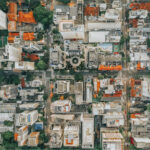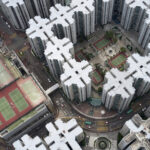The neighborhood’s physical environment influences health through environmental exposures such as air pollution, water quality, and heavy metals in the soil. Living in communities with higher levels of toxic ecological exposures increases residents’ risk of adverse health outcomes ranging from asthma (Guarneri & Balmes, 2014; Nardone et al., 2018) to cancer.
The structures people have created, or the “built environment,” also impact health (Gomez et al., 2015). For example, housing quality and crowding, land use, transportation, street design and connectivity, traffic density, and aesthetic quality impact the amount of toxic stress community residents and workers (Hoehner et al., 2013) experience, and prolonged stress can damage health. The availability of parks, green space, safe walking paths, and recreation facilities make it easier to be active, which improves health. The built environment also includes the amount of healthy vs. unhealthy food options, proximity to healthcare, social services, and other critical resources needed to achieve optimal health (Diez-Roux & Mair, 2010; Gomez et al., 2015; Renalds et al., 2010). For example, living in a community with a scarcity of fresh fruits and vegetables but an abundance of fast food, processed food, and alcohol outlets can diminish residents’ diet, directly impacting numerous health outcomes (Hager et al., 2017). While we generally think of urban environments when we think of neighborhoods, there is also a body of literature examining the health impacts of different characteristics of rural settings.
- Diez-Roux, A. V., & Mair, C. (2010). Neighborhoods and health. Annals of the New York Academy of Sciences, 1186(1), 125-145.
- Gomez, S. L., Shariff‐Marco, S., DeRouen, M., Keegan, T. H., Yen, I. H., Mujahid, M., Satariano, W. A., & Glaser, S. L. (2015). The impact of neighborhood social and built environment factors across the cancer continuum: current research, methodological considerations, and future directions. Cancer, 121(14), 2314-2330.
- Hager, E. R., Cockerham, A., O’Reilly, N., Harrington, D., Harding, J., Hurley, K. M., & Black, M. M. (2017). Food swamps and food deserts in Baltimore City, MD, USA: Associations with dietary behaviors among urban adolescent girls. Public health nutrition, 20(14), 2598-2607.
- Renalds, A., Smith, T. H., & Hale, P. J. (2010). A systematic review of built environment and health. Fam Community Health, 33(1), 68-78.
- Guarnieri, M., & Balmes, J. R. (2014). Outdoor air pollution and asthma. The Lancet, 383(9928), 1581-1592.
- Nardone, A., Neophytou, A. M., Balmes, J., & Thakur, N. (2018). Ambient air pollution and asthma-related outcomes in children of color of the USA: a scoping review of the literature published between 2013 and 2017. Current allergy and asthma reports, 18(5), 1-12.
- Hoehner, C. M., Allen, P., Barlow, C. E., Marx, C. M., Brownson, R. C., & Schootman, M. (2013). Understanding the independent and joint associations of the home and workplace built environments on cardiorespiratory fitness and body mass index. American journal of epidemiology, 178(7), 1094-1105.





